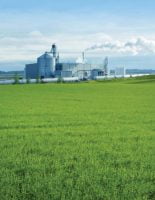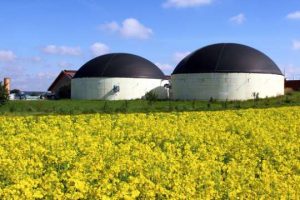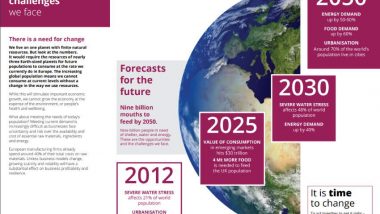The AD Process is the way biogas is produced. The “Anaerobic Digestion Process” to give it its full name, is simply rotting or composting in the absence of air. It can be a form of Waste Management, but most importantly it produces biogas. Biogas used wisely produces renewable energy, natural fertiliser, biomethane. It is a force for good. But, if it escapes into the air, it is 23 times more damaging as a greenhouse gas than carbon dioxide.
“Did you know that landfills make biogas by this process. They do. And, a lot of it!”

When this article was first written in 2007 more than 65% of all Municipal Solid Waste (MSW) in the UK generated in England was disposed of in landfills. Now in 2019 less than 25% is landfilled in the United Kingdom. UK and European contributions have reduced substantially as a result. But, globally landfill has risen since then. Overall the emission of biogas – which leads to a very high greenhouse effect, has been increasing rapidly.
Landfill Diversion to Reduce Global Warming from Escape of Landfill Gas (Biogas)
The introduction of the EC landfill directive in the early 2000s meant that the European Commission set targets to reduce the levels of biodegradable materials going to landfill. Those targets have been met throughout Britain, and exceeded so far. Throughout Europe there has been general compliance, so the greenhouse gas emissions from landfill will have been reducing since the 2000s, unlike elsewhere in many nations globally.

The most significant challenge facing the management of Municipal Solid Waste is how to divert the biodegradable component of MSW away from landfills. Biodegradable Municipal Waste (BMW) is the fraction that will break down naturally in the environment, and it is the content within the rubbish that goes into landfills which causes the nuisance smalls and attracts birds etc.
This organic waste includes feedstocks such as: food or kitchen wastes, green or garden wastes, paper, cork and non man-made textiles (eg cotton and wool). The need to reduce the levels of biodegradable materials going to landfill is based on concerns over greenhouse gas emissions that contribute to global warming.
The decomposition of biodegradable materials within landfill sites results in the production of methane, a potent greenhouse gas. One of the best options for dealing with the biodegradable fraction of municipal solid waste is Anaerobic Digestion. It's also considered to be a form of organic waste treatment. Treatment in this context, simply means changing the chemicals present to make them less potentially damaging to the environment.
It is a natural process. It is simply rotting or composting in the absence of air. The magic is though that it produces methane, and methane is a raw product which can be sued to make biofuels including bio-diesel, and many others.
It costs a bit more than composting or disposal to landfill but the benefits are tremendous, especially to farmers.
We suggest that you watch our video below which explains the AD process which makes biogas (renewable energy).
Now visit our anaerobic digestion web site and read more.
The Biogas Production Process (AD)
 Many microorganisms affect anaerobic digestion, including acetic acid-forming bacteria (acetogens) and methane-forming archaea (methanogens). These organisms promote a number of chemical processes in converting the biomass to biogas.
Many microorganisms affect anaerobic digestion, including acetic acid-forming bacteria (acetogens) and methane-forming archaea (methanogens). These organisms promote a number of chemical processes in converting the biomass to biogas.
Gaseous oxygen is excluded from the reactions by physical containment. Anaerobes utilize electron acceptors from sources other than oxygen gas. These acceptors can be the organic material itself or may be supplied by inorganic oxides from within the input material.
When the oxygen source in an anaerobic system is derived from the organic material itself, the ‘intermediate' end products are primarily alcohols, aldehydes, and organic acids, plus carbon dioxide.
In the presence of specialised methanogens, the intermediates are converted to the ‘final' end products of methane, carbon dioxide, and trace levels of hydrogen sulfide. In an anaerobic system, the majority of the chemical energy contained within the starting material is released by methanogenic bacteria as methane.
Populations of anaerobic microorganisms typically take a significant period of time to establish themselves to be fully effective. Therefore, common practice is to introduce anaerobic microorganisms from materials with existing populations, a process known as “seeding” the digesters, typically accomplished with the addition of sewage sludge or cattle slurry. via Wikipedia
AD Process Stages
The AD process stages are:
1. Hydrolysis
2. Acetogenesis
3. Methanogenesis
The (AD) Anaerobic Digestion Process Biological Principles
The digestion process begins with bacterial hydrolysis of the input materials in order to break down insoluble organic polymers such as carbohydrates and make them available for other bacteria. Acidogenic bacteria then convert the sugars and amino acids into carbon dioxide, hydrogen, ammonia, and organic acids. Acetogenic bacteria then convert these resulting organic acids into acetic acid, along with additional ammonia, hydrogen, and carbon dioxide. Finally, methanogens convert these products to methane and carbon dioxide. via ABC
What is made during the AD process?
Biogas is generated during anaerobic digestion when microorganisms break down (eat) organic materials in the absence of air (or oxygen) in AD plants. Biogas is mostly methane (CH4) and carbon dioxide (CO2), with very small amounts of water vapor and other gases. The carbon dioxide and other gases can be removed, leaving only the methane. Methane is the primary component of natural gas.
It is used to produce power (electricity) and with additional processing is further purified to become a from of renewable natural gas known as “biomethane”.
The material that is left after anaerobic digestion happens is called “digestate.” Digestate is a wet mixture that is usually separated into a solid and a liquid. Digestate is rich in nutrients and can be used as fertilizer for crops. via infoabout(AD)
Anaerobic Digestion from Appropedia: The Sustainability Wiki
Anaerobic digestion is a process in which microorganisms break down biodegradable material in the absence of oxygen. The products of this are biogas (a mixture of carbon dioxide (CO2) and methane) and digestate (a nitrogen-rich fertiliser).
The biogas can be burned to produce heat, or can be cleaned and used in the same way as natural gas or as an automobile fuel. The waste digestate is rich in minerals and can be used as an agricultural fertiliser or soil conditioner.
Application
The wet anaerobic process is widely used to treat wastewater sludges and organic wastes because it provides volume and mass reduction of the input material. As part of an integrated waste management system, anaerobic digestion reduces the emission of landfill gas into the atmosphere.
Dry anaerobic digestion has been used widely too.
For example, there is the Axpo Kompogas AG system. This is a fully developed system and has produced 27 million Kwh of electricity and Biogas in 2009. The oldest of the companies own lorries has achieved 1,000,000 kilometers driven with biogas from household waste in the last 15 years. By any analysis that's a worthwhile record.
Anaerobic digestion is a renewable energy source because the process produces a methane and carbon dioxide rich biogas suitable for energy production helping replace fossil fuels. Also, the nutrient-rich solids left after digestion can be used as fertilizer
AD Processes
2 types of AD plant processes exist: the process for wet anaerobic digestion' and for dry anaerobic digestion.
In both types of process, there are a number of bacteria that are involved in the process of anaerobic digestion including acetic acid-forming bacteria (acetogens) and methane-forming bacteria (methanogens).
These bacteria feed upon the initial feedstock, which undergoes a number of different processes converting it to intermediate molecules including sugars, hydrogen & acetic acid before finally being converted to biogas.
Different species of bacteria are able to survive at different temperature ranges. Ones living optimally at temperatures between 35-40°C are called mesophiles or mesophilic bacteria. Some of the bacteria can survive at the hotter and more hostile conditions of 55-60°C, these are called thermophiles or thermophilic bacteria.
Methanogens come from the primitive group of archaea. This family includes species that can grow in the hostile conditions of hydrothermal vents. These species are more resistant to heat and can therefore operate at thermophilic temperatures, a property that is unique to bacterial families.
As with aerobic systems the bacteria in anaerobic systems the growing and reproducing microorganisms within them require a source of elemental oxygen to survive. via Appropedia: The sustainability wiki
Conclusion to “the AD Process which Makes Biogas”
The AD Process which produces biogas, holds great potential. It is not glamorous to talk about waste, especially foul and human waste, and yet many anaerobic digestion's great advantages are to do with processing waste.
Unfortunately, it is in danger of being largely ignored by politicians and the media for its unpleasant associations with waste of all types. It is also associated, very often wrongly with producing odors, although the volatile fatty acids which often cause this need to be carefully handled to prevent odor.
This is very unfortunate.
Having read this article do you think you will be keener to defend or promote the AD process?
Article History: This article was first written in 2007 and was extensively re-written in 2019. Since 2007 the need for the diversion of organic materials away from landfill has become even more urgent. Although many nations do recognise the damage which is done by landfill gas which escapes into the atmosphere and collect the gas that can be collected, all the time more and more landfill gas is being created in the landfills of the developing nations.







The AD Process which makes biogas does take food waste and crop waste but what about what is left-over after. Does that go to landfill?